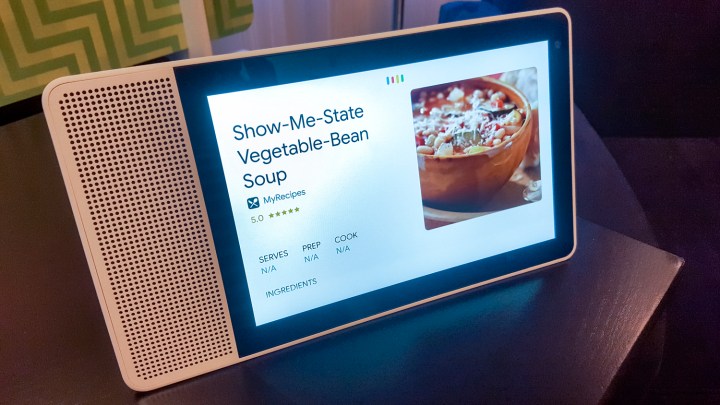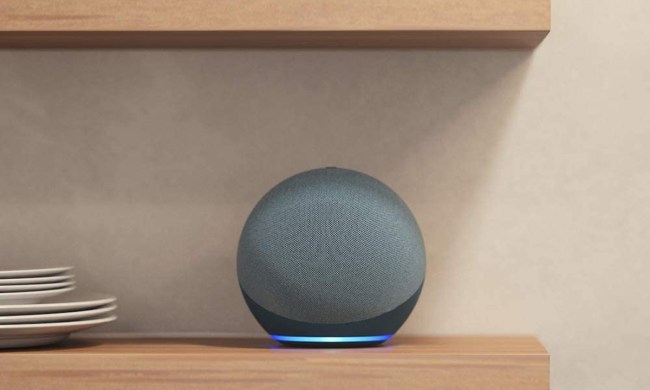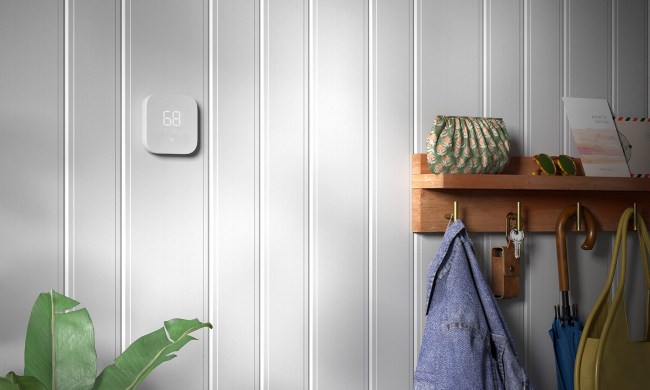If you’ve been watching for the latest smart tech and coolest new gadgets, then you’ve probably noticed the term “smart display” being used more often. Some products, like the Lenovo Smart Display (which we really liked), even have the phrase in the name. But what does “smart display” really mean, why is it becoming popular, and what differentiates it from all the other available tech? Let’s take a closer look.
Smart display: The easy definition

A smart display is any voice assistant smart speaker designed to be used around the home, which also includes a sizable touchscreen. Specifically, these devices have touchscreens that you can use for more than just controls—screens that support entertainment, informational videos, video chats, and much more. They can also connect to and control other smart devices in the house.
In practice, the smart displays we’re seeing on the market are smart Bluetooth speakers that are being augmented with screens to add more usability. Like smart speakers, you speak to a smart display that is powered by one of the common voice assistants (Amazon Alexa or Google Assistant). Amazon was one of the first to start this trend with its Echo Show and Echo Spot devices featuring Alexa voice assistant, but other brands have joined the field. For instance, Google came out with the Google Home Hub, and Facebook recently introduced the Facebook Portal and Portal+.
Smart display vs. tablet

“Wait,” you may be thinking, “I have a voice assistant and video apps on my tablet. What exactly is the difference here?” The big difference between the average tablet like an iPad and a smart display like the Echo Show is mobility. A tablet is designed to be carried with you, and is only stationary when you are. A smart display is meant to occupy the same spot for a long time—like a land phone or alarm clock—and doesn’t take up a free hand.
Smart displays also have a much tighter focus on voice assistant commands and video-oriented capabilities. This specialization makes smart displays very easy to use, even without training: You just talk to them. That can appeal to a broader audience than tablet computers. Smart displays are also set up so that you can control smart devices, like light switches and front door locks, with just your voice.
Smart display products on the market

Lenovo Smart Display: The Lenovo Smart Display, available in two different sizes (10-inch and 8-inch screens), uses Google Assistant to provide video chats, play cooking and other videos from sources like YouTube, and control your smart home. It can also play music from a variety of sources. It’s a particularly good smart display if you already use Google Assistant or are a fan of Google Home. The display is crystal clear, and you can easily turn off the camera button if you want privacy.
JBL Link View: This oval speaker with an 8-inch smart display also uses Google Assistant to help manage smart devices, video chats, visual web searches, and so on. It also supports Google Cast for beaming the same audio to multiple speakers around the house and boasts a rear-facing passive radio for stronger bass. We were impressed with the sound.
LG WK9: LG’s entrant in the smart display category is a ThinQ Bluetooth speaker with a touchscreen that works via Google Assistant. The 8-inch screen includes video chat capabilities and the ability to do things like watch cooking videos on YouTube. It’s a good option for those who care a lot about the audio quality of their speaker, but the blocky design is a little disappointing. The device isn’t available for purchase yet, but will be soon.

Amazon Echo Show: The Echo Show was one of the very first smart speakers to add a smart screen. Of course, the big difference here is that Amazon uses its own interface and search functions with Alexa instead of Google Assistant. This allows the Show to use screen-compatible Alexa skills, like watching video news stories. It also allows you to watch Amazon Prime Video shows or movies, which is nice if you prefer Prime content. You can also control all compatible smart devices.
Amazon Echo Spot: The Spot is a small, round version of the Show. It’s not really big enough for videos and is primarily intended to act as an alarm clock that can also function as a video chat phone. It’s cool if you use these functions, but is somewhat limited.
Google Home Hub: The Google Home Hub is Google’s competitor to the Echo Show. It has a seven-inch display, and it’s powered by Google Assistant. It has a screen, but it does not have a camera. The lack of a camera means you can’t make Skype calls, but you also won’t have to worry as much about privacy. It’s not the best for sound, but is great for smart home control. It’s also more versatile, with a smaller footprint that means you can put it anywhere.
Facebook Portal: Facebook Portal is an Amazon Alexa-enabled smart speaker with a video display. It can control your smart home devices, and do a lot of the same things as other Alexa-enabled devices. However, Facebook Portal also has A.I. technology in the cameras and microphones called 2D Pose. This makes allows the device to tell the difference between a person and other objects in the room. The cameras follow you around the room, automatically using features like pan and zoom to make the screen move with you. Portal is designed to make you feel like you’re talking to someone in person, rather than on the display screen. The Portal isn’t available to buy yet, but will be soon.
Facebook Portal+: Facebook Portal+ is just like the regular Portal, except for its size and a few other features. While the regular Portal has a 10.1-inch display, the Portal+ has a 15.6-inch display and it rotates from portrait to landscape. The resolution is better on the Portal+ (1080p), when compared to the regular portal which is only 720p resolution. Additionally, the Portal+ has better sound, with 20w speaker output, two tweeters, and a single four-inch bass speaker. The regular Portal has 10w speaker output from two full-range drivers.
Future of the smart display
Expect the number of smart displays on the market to keep increasing, at least for now (note that Apple does not yet have one out). This is still a new field, and brands will want to explore how it can be used. There’s a lot of room for growth and new specialties here.
There’s also a lot of room for new content experiences, including more ads…which could be a weak point in the smart display field. Currently, smart displays use a fairly mild ad format with generic, screensaver-like notifications when the smart display is not in use. But Google has developed more in-depth smart display ad campaigns that could pave the way for more advertisements on these devices—for better or worse.



